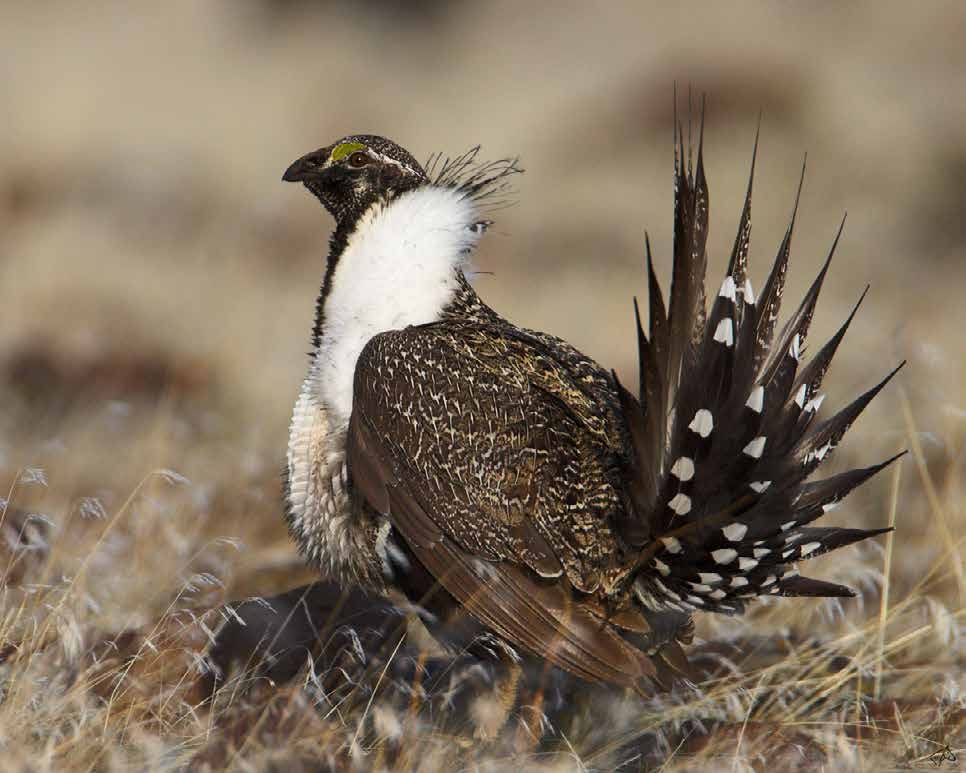The Conservation Column
By Pepper Trail
As I write this, it’s shortly before Thanksgiving, and I’m thinking about the conservation of Oregon’s most magnificent native fowl. No, not the turkey, which as I’m sure all Auduboners know, is NOT native to Oregon, but rather an introduction by ODFW to provide hunters with another target. No, I’m talking about the Greater Sage-Grouse, native to the sagebrush country of eastern Oregon and much of the Interior West.
The Bad News
Last March, the Department of the Interior and Bureau of Land Management (BLM) chose to make dramatic changes to the 2015 sagebrush management plans agreed upon by more than 10 states in the Interior West, making it even easier for oil and gas companies to lease and drill in sage-grouse habitat. National Audubon, along with the National Wildlife Federation and the Wilderness Society, found that the Department of the Interior failed to prioritize oil and gas leasing and drilling outside sage-grouse habitat, as the 2015 and 2019 sagebrush management plans mandate. Between January 2017 and March 2019, the BLM issued leases comprising almost 1.6 million acres and 2,553 drilling permits in sage-grouse habitat.
National Audubon has now documented three consecutive years of sharp declines in five states that hold more than 80 percent of the population. Sage-grouse numbers are known to swing widely, but the losses are too big to be ex-plained by those roughly decade-long boom-and-bust cycles, according to Clait Braun, a retired biologist who studied the birds for the Colorado Division of Wildlife.
The new figures, based on spring counts at the Greater Sage-Grouse mating areas known as leks, are “very worrisome,” Braun told Audubon magazine. “There’s no way to sugarcoat it.” The Idaho population, for example, has plunged by 52 percent since 2016, with a 25 percent loss this year alone. Oregon likewise lost a quarter of its sage-grouse in the past year, following two years of more modest declines. In Nevada, the population has shrunk by one-third over the past three years, while Wyoming—which has more of the birds than any other state—lost 28 percent of them since last year. And although the numbers for one of Colorado’s six lek counts aren’t yet final, those with complete data show a 69 percent contraction since 2016.
Advocates have long warned that continued development in sage-grouse habitat—along with increasingly destructive wildfires that wipe out huge tracts of sage-brush—could eventually trigger a listing under the Endangered Species Act. But now that potential safety net has some grouse-sized holes. On August 12, the administration finalized new rules for implementing the Act that would, for the first time, allow economic factors to be considered in listing decisions—a change that could have major implications for a bird that does its famous mating dance atop oilfields. The changes, which environmental groups have sued to stop, also end the policy of automatically granting threatened species the same safeguards as endangered ones, so sage-grouse could potentially be listed as threatened but receive little actual protection.
A New Hope
This October, Judge B. Lynn Winmill, a Clinton appointee to the U.S. District Court for the District of Idaho, sided with environmental groups challenging revisions to the Obama-era Greater Sage-Grouse protection plans, approving an order blocking the Bureau of Land Management from implementing the revisions on 51 million acres of grouse habitat. The ruling required BLM to revert to evaluating leases under sage grouse plans the Obama administration finalized in 2015. .
Following the ruling, BLM Nevada quietly posted on its website that it had removed parcels covering 332,247 acres of land from its Tuesday lease sale for “further analysis” as a result of Winmill’s injunction. The change was listed under “Errata #3” on the state BLM page and was not publicized by the agency. More recently, BLM has cancelled additional lease sales in Colorado, Nevada, and Utah.
Conservation groups lauded the move, while urging BLM to take more permanent action to stop lease sales on the birds’ habitat. Other state offices could defer or cancel leases as more sales approach in December.
“Now BLM needs to keep doing the right thing: No more oil and gas leasing in greater sage-grouse habitat or anywhere else,” Kelly Fuller, energy and mining campaign director at the Western Watersheds Project, wrote in an email. “To protect human life, wildlife, and habitat, BLM must stop all new oil and gas leasing. It is time to keep fossil fuels in the ground,” she continued. Conservation groups opposing the Bureau of Land Management’s actions say a recent slate of deferred lease sales in Colorado, Nevada and Utah illustrate the problems with the Trump administration’s aggressive push to encourage energy development on public lands.
“The broader pattern we’ve seen from this administration has been a headlong rush to get as much remaining sage grouse habitat under lease as possible,” said Michael Saul, a senior attorney at the Center for Biological Diversity’s public lands program. He said the Trump administration’s “energy dominance” approach has led BLM to violate federal laws like the National Environmental Policy Act.
“That needs to stop,” Saul said. “They are not simply a real estate sales agency. Under congressional statute, they have multiple obligations, which include duties to conserve wildlife habitat.”
As I enjoy my Thanksgiving turkey this year, I will give thanks for the efforts of conservationists who love and continue to fight for the Greater Sage-Grouse and all our native birds, in this most challenging of times. That includes all RVAS members. Here’s to more hard-won victories in 2020!


Leave A Comment
You must be logged in to post a comment.